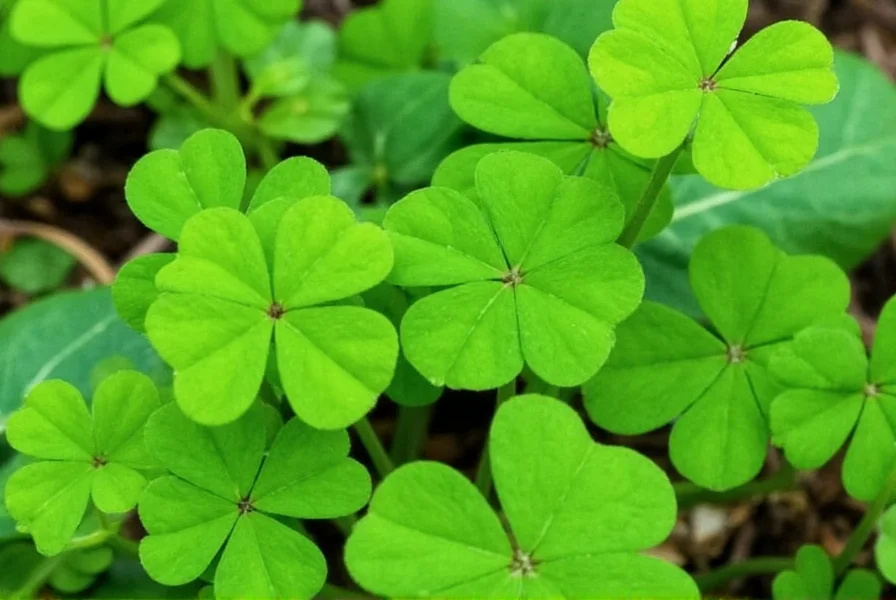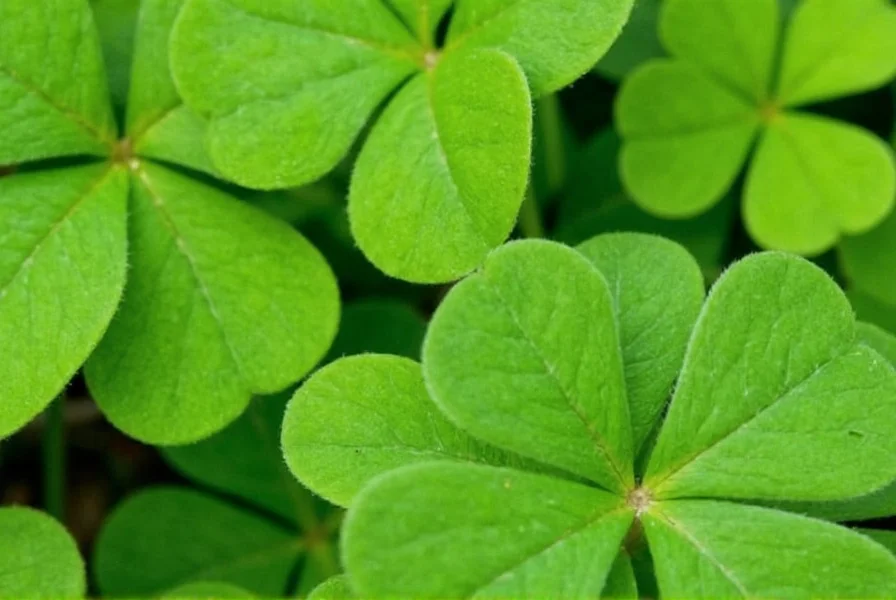Dutch clover (Trifolium repens), often called white Dutch clover, represents one of the most versatile and sustainable ground cover options available to gardeners and landscapers. This hardy perennial legume has gained significant popularity as an eco-friendly alternative to conventional turf grass, particularly among those seeking low-maintenance, pollinator-friendly lawn solutions.
Understanding Dutch Clover Characteristics
Dutch clover distinguishes itself through several key botanical features that make it particularly valuable for various applications. The plant typically grows 4-8 inches tall with creeping stems that root at the nodes, creating a dense mat that effectively prevents soil erosion. Its trifoliate leaves feature the characteristic "V" watermark pattern common to many clover species, while its flowers appear as small white or pink-tinged spherical clusters that attract bees and other beneficial insects.
Unlike some aggressive clover varieties, Dutch clover maintains a relatively controlled growth habit, making it suitable for mixed lawn applications where a balance between aesthetics and functionality is desired. Its deep root system, reaching up to 18 inches, enables remarkable drought tolerance once established, while the plant's ability to fix atmospheric nitrogen significantly reduces or eliminates the need for synthetic fertilizers.

Historical Background and Origin
Despite its "Dutch" designation, this clover variety actually originated in Europe and was widely adopted by Dutch farmers for pasture improvement during the 17th and 18th centuries. The name "Dutch" refers to the agricultural practices of Dutch farmers who perfected its cultivation rather than its geographic origin. Historical records show Dutch clover was intentionally introduced to North America during colonial times, where it quickly established itself in fields and meadows.
The plant's agricultural value became particularly apparent during the 19th century when farmers recognized its soil-enhancing properties. Unlike many modern turf grasses that deplete soil nutrients, Dutch clover actively improves soil fertility through nitrogen fixation—a process where symbiotic bacteria in root nodules convert atmospheric nitrogen into plant-available forms.
Benefits of Incorporating Dutch Clover
The advantages of using Dutch clover extend far beyond simple aesthetics. When properly established, this versatile plant offers multiple ecological and practical benefits:
| Benefit Category | Specific Advantages |
|---|---|
| Soil Health | Nitrogen fixation, erosion control, improved soil structure, organic matter addition |
| Maintenance | Reduced mowing frequency, minimal watering needs, natural weed suppression |
| Ecological | Pollinator support, biodiversity enhancement, reduced chemical dependency |
| Economic | Lower water bills, eliminated fertilizer costs, extended lawn lifespan |
One of Dutch clover's most significant advantages for sustainable landscaping is its ability to thrive in conditions where traditional grasses struggle. It tolerates moderate foot traffic better than many alternative ground covers while maintaining its green appearance during dry periods that would cause conventional lawns to brown.
Dutch Clover vs. Other Clover Varieties
When considering clover for landscaping purposes, understanding the differences between varieties proves essential. Dutch clover differs from other common types in several important ways:
- Microclover: A newer cultivar bred specifically for lawns, microclover features smaller leaves and flowers with even lower growth habits (2-4 inches), making it less noticeable in mixed lawns
- Alsike Clover: Grows taller (12-24 inches) with pinkish-white flowers, better suited for pasture than lawns
- Red Clover: A biennial with larger pink flower heads, typically used for forage rather than turf
- Crimson Clover: An annual with striking red flowers, primarily used as a cover crop
Among these options, Dutch clover strikes the optimal balance between lawn functionality and ecological benefits for most residential applications. Its moderate height and dense growth pattern create a uniform appearance that many homeowners find aesthetically pleasing while still providing substantial environmental advantages.
Practical Applications in Modern Landscaping
Today's gardeners utilize Dutch clover in several innovative ways that maximize its benefits while addressing traditional lawn challenges:
As a Standalone Lawn Alternative
Many environmentally conscious homeowners are replacing traditional grass lawns entirely with Dutch clover. This approach eliminates the need for frequent mowing (typically only required 3-4 times per season), reduces water consumption by up to 50%, and creates a naturally green space that remains attractive throughout the growing season. The subtle white flowers add visual interest while supporting local pollinator populations.
In Mixed Lawn Blends
For those not ready to commit to a complete lawn transformation, incorporating Dutch clover into existing grass lawns offers significant advantages. A blend containing 5-15% Dutch clover seeds mixed with turf grass varieties creates a more resilient lawn that requires less maintenance while improving overall soil health. This approach works particularly well for repairing bare spots in existing lawns.
As a Cover Crop
Gardeners and farmers utilize Dutch clover as a living mulch between vegetable rows or in orchards. Its nitrogen-fixing properties nourish neighboring plants while its dense growth suppresses weeds and conserves soil moisture. When terminated, Dutch clover decomposes to add organic matter to the soil.
Planting and Maintenance Guidelines
Establishing a successful Dutch clover lawn or patch requires attention to proper planting techniques and initial care:
Optimal Planting Conditions
For best results, plant Dutch clover seeds in early spring (March-April) or early fall (August-September) when soil temperatures range between 50-65°F (10-18°C). Prepare the soil by removing existing vegetation and lightly raking to create good seed-to-soil contact. The recommended seeding rate is 2-3 pounds per 1,000 square feet for pure stands or 0.5-1 pound when mixing with grass seed.
Watering Requirements
During establishment (first 3-4 weeks), keep the soil consistently moist but not saturated. Once established, Dutch clover demonstrates remarkable drought tolerance, requiring supplemental watering only during extended dry periods. Overwatering can encourage fungal diseases and reduce the plant's natural resilience.
Mowing Practices
Unlike traditional lawns, Dutch clover benefits from infrequent mowing. Allow plants to reach 6-8 inches before cutting back to 3-4 inches. Mowing too frequently prevents flowering, which reduces pollinator benefits. Many homeowners choose to mow only when necessary to maintain a uniform appearance or to prevent excessive seed production.
Fertilization Needs
One of Dutch clover's greatest advantages is its minimal fertilizer requirements. The plant's nitrogen-fixing ability typically eliminates the need for nitrogen applications. In cases of phosphorus or potassium deficiency (determined by soil test), apply a balanced organic fertilizer at half the rate recommended for grass lawns.
Addressing Common Concerns
Despite its many benefits, some gardeners express concerns about incorporating Dutch clover into their landscapes:
Weed Competition: During establishment, Dutch clover may struggle with aggressive weeds. Proper site preparation and consistent moisture during germination help establish a dense stand that naturally suppresses weeds.
Foot Traffic Tolerance: While Dutch clover handles moderate foot traffic well, high-traffic areas may require reinforcement with stepping stones or a higher percentage of turf grass in mixed lawns.
Allergies: Unlike many grasses that produce wind-pollinated pollen causing allergies, Dutch clover's insect-pollinated flowers rarely contribute to seasonal allergies.
Conclusion
Dutch clover represents a practical, sustainable solution for modern landscaping challenges. Its ability to thrive with minimal inputs while providing ecological benefits makes it increasingly relevant in an era of water conservation and pollinator decline. Whether used as a complete lawn replacement, incorporated into existing grass lawns, or utilized as a cover crop, Dutch clover offers a versatile option that aligns with contemporary environmental priorities without sacrificing aesthetic appeal. As more homeowners seek alternatives to resource-intensive traditional lawns, Dutch clover's popularity continues to grow as a smart, sustainable choice for conscientious gardeners.
Is Dutch clover the same as white clover?
Yes, Dutch clover is a specific cultivar of white clover (Trifolium repens). While all Dutch clover is white clover, not all white clover varieties are Dutch clover. Dutch clover refers to selected cultivars bred for lawn and turf applications with more consistent growth habits and denser coverage than wild white clover varieties.
How does Dutch clover handle drought conditions compared to traditional grass?
Dutch clover demonstrates superior drought tolerance compared to most traditional turf grasses. Its deep taproot system (reaching up to 18 inches) allows it to access moisture unavailable to shallow-rooted grasses. During dry periods, Dutch clover may go dormant but typically recovers quickly when water becomes available, whereas many grass varieties turn brown and may die without regular irrigation.
Will Dutch clover take over my entire lawn if I plant it?
Dutch clover spreads gradually through stolons (above-ground stems) but is not aggressively invasive. In mixed lawns, it typically maintains a balanced presence rather than completely overtaking grass. If you prefer to contain it, regular mowing and creating physical barriers at lawn edges will effectively manage its spread.
Does Dutch clover attract bees, and is this a concern for families with children?
Yes, Dutch clover attracts bees with its nectar-rich flowers, which benefits local pollinator populations. However, the bees drawn to Dutch clover are typically non-aggressive species focused on feeding rather than defending territory. The risk of stings is minimal, especially compared to other common yard insects. Mowing before peak flowering can reduce bee activity if this remains a concern.
How often should I reseed Dutch clover to maintain a healthy lawn?
Dutch clover typically self-seeds effectively, reducing the need for frequent reseeding. Most established Dutch clover lawns require supplemental seeding only every 2-3 years to maintain density. Overseeding in early spring or fall with 0.5-1 pound of seed per 1,000 square feet helps fill in thin areas and rejuvenate the stand.











 浙公网安备
33010002000092号
浙公网安备
33010002000092号 浙B2-20120091-4
浙B2-20120091-4